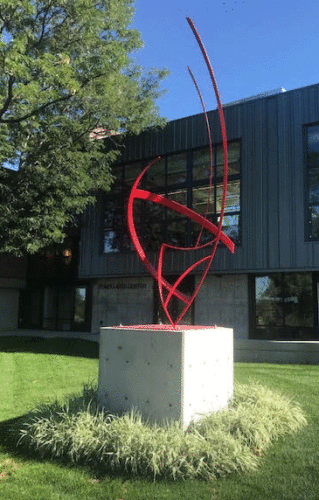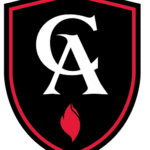 Each morning as I walk towards the Middle School at Colorado Academy, I pass the new red sculpture in front of the Ponzio Arts Center titled, “Peregrine.” While art is wonderfully open to interpretation, I enjoy believing that this sculpture represents the “flame of knowledge” that is near the center of our school crest. In this sense each day I am reminded of what is central to our mission, igniting in each student curiosity and, hopefully, starting them down the journey towards knowledge. I emphasize journey, because the path will be circuitous with wonderful twists and turns.
Each morning as I walk towards the Middle School at Colorado Academy, I pass the new red sculpture in front of the Ponzio Arts Center titled, “Peregrine.” While art is wonderfully open to interpretation, I enjoy believing that this sculpture represents the “flame of knowledge” that is near the center of our school crest. In this sense each day I am reminded of what is central to our mission, igniting in each student curiosity and, hopefully, starting them down the journey towards knowledge. I emphasize journey, because the path will be circuitous with wonderful twists and turns.
The role of teachers and curriculum
Our most precious resource as a school is time. We get to be with students from 8:10-3:30, no more, no less…27,600 seconds each day. The decisions teachers make in how to best use these moments drive our ability to spark and nurture curiosity, directing student attention toward those ideas, problems, innovations, skills, and complexities that we believe are most productive. Our ally in this process is a well-crafted curriculum, one which asks students to be full participants in their own learning, one that invites students to be explorers and pioneers, not passive receivers of discrete tidbits of information.
ThinkingLAB and the neuroscience of learning
 This is why at CA we make intentional decisions about what skills and processes to prioritize. We believe that the majority of student time should be directed toward teaching students the skills of critical thinking, problem solving, collaboration, communication, and cultural competence. We do this through a program we call ThinkingLAB. Each instructor intentionally teaches this skill set through student-directed projects, problem solving using the Design Thinking process, and by asking students to complete CWRA (College Work and Readiness) types of assignments.
This is why at CA we make intentional decisions about what skills and processes to prioritize. We believe that the majority of student time should be directed toward teaching students the skills of critical thinking, problem solving, collaboration, communication, and cultural competence. We do this through a program we call ThinkingLAB. Each instructor intentionally teaches this skill set through student-directed projects, problem solving using the Design Thinking process, and by asking students to complete CWRA (College Work and Readiness) types of assignments.
We know from research that repeated practice is the only thing that can literally “wire” the brain and that what we do time and time again strengthens synaptic connections. If we want kids to be good at problem solving, we must give them lots and lots of practice problem solving. If we want them to be great at video games, the same is true. In this sense, the best schools choose wisely about skill targets and are relentless in the pursuit of giving students practice and feedback on the hard and soft skills that will allow each over time to develop fluency.